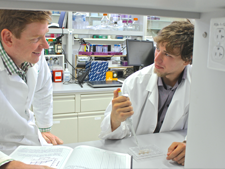In the Kolber Lab, we try to understand the common mechanisms of chronic pain and psychiatric illness. This is done by integrating cutting-edge behavioral, pharmacological, electrophysiological, optogenetic, and molecular techniques to understand the mechanisms of stress and pain.
 Amygdala and Pain
Amygdala and Pain
Most of our work is focused on studying the amygdala, which is a small structure in the brain involved in processing stressful stimuli, modulating reactions to a stressor, and modulating pain responses. Depending on the emotional state of an organism, activation of the amygdala can either increase or decrease pain. We are trying to understand the molecular and cellular components of this processing. The precise types of pain that we are interested in understanding include disorders with a clear connection to stress (e.g. painful bladder syndrome/interstitial cystitis) as well as those that are less commonly associated with emotional dysregulation.
Drug Discovery
We are also heavily involved in drug discovery for both pain and depression. This work focuses on novel therapeutics targeting G-protein couple receptors. Collaborating with Dr. Kevin Tidgewell (Duquesne University School of Pharmacy), we are finding novel compounds from Caribbean and Central American marine cyanobacteria. By using a natural products approach to drug discovery, we hope to find novel chemical scaffolds to develop the next generation of non-opioid pharmacological agents.
Exercise, Meditation and Pain
Finally, we are interested in investigating the use of exercise and meditation to treat pain. These studies have included basic science mechanistic studies (in exercise with mice) and clinical approaches in healthy human volunteers and chronic pain patients. For these studies, we collaborated with Drs. Kim Szucs and Matt Kostek in the Duquesne University Rangos School of Health Science, Drs. Ian Edwards and Timothy Smith in the Center for Well-Being as well as investigators at the University of Pittsburgh such as Drs. Eric Helm and Natalia Morone.
 Basic science approaches used in the lab include behavioral tests (e.g. nociceptive tests, anxiety tests, depression tests, learning and memory tasks), physiology (e.g. in vivo recording from the brain, EMG recording during peripheral stimulation), optogenetics, genetic manipulation (e.g. disrupting or activating genes using viral constructs), and molecular/cellular techniques (e.g. PCR, RT-PCR, immunohistochemistry, Western analysis, cell culture, and cloning). Clinical approaches used in the lab include qualitative measures of pain and anxiety as well as quantitative sensory testing and physiological measurements in human participants.
Basic science approaches used in the lab include behavioral tests (e.g. nociceptive tests, anxiety tests, depression tests, learning and memory tasks), physiology (e.g. in vivo recording from the brain, EMG recording during peripheral stimulation), optogenetics, genetic manipulation (e.g. disrupting or activating genes using viral constructs), and molecular/cellular techniques (e.g. PCR, RT-PCR, immunohistochemistry, Western analysis, cell culture, and cloning). Clinical approaches used in the lab include qualitative measures of pain and anxiety as well as quantitative sensory testing and physiological measurements in human participants.
Basic science trainees working in the lab receive a broad-based training in behavior, neuroanatomy, surgical techniques, and molecular biology. Clinically-oriented trainees working in the lab receive specific training in movement-based therapies to treat chronic pain including experimental design and human testing techniques. These training regiments provide a strong foundation for future success in research and medicine.
Funding (Past and Current)
- Beta Beta Beta – Undergraduate Research Grant Fund
- American Pain Society – Sharon S. Keller Chronic Pain Research Program
- American Physiological Society – Undergraduate Research Program
- International Association for the Study of Pain and the SCAN|Design Foundation – Early Career Research Grant
- International Association for the Study of Pain – Collaborative Research Grant
- National Institutes of Health – National Center for Complementary and Integrative Health
- National Institutes of Health – National Institute of Diabetes and Digestive and Kidney Diseases
- National Institutes of Health – National Institute on General Medical Sciences
- National Institutes of Health – National Institute on Drug Abuse
- National Institutes of Health – National Institute of Neurological Disorders and Stroke